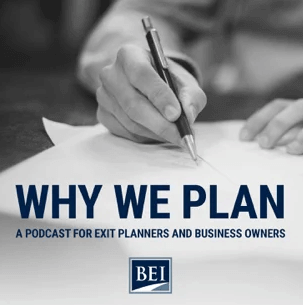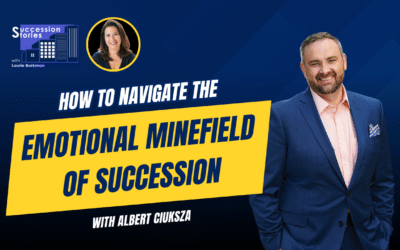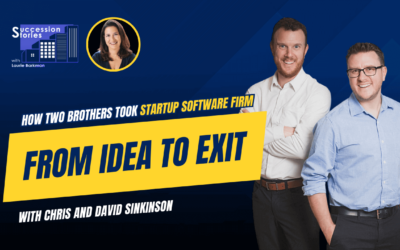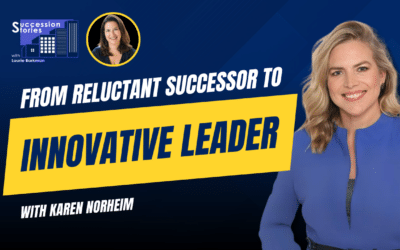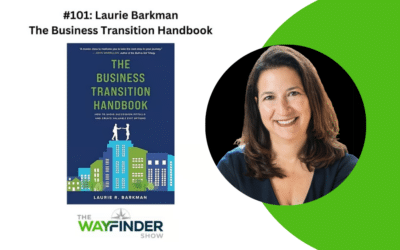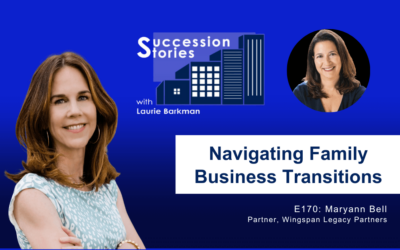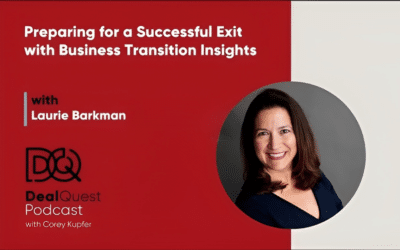Sometimes traditional marketing tactics simply don’t work. But once you understand your target audience and what they are most interested in, it becomes significantly easier to create engaging content for them. John Brown, Founder of Business Enterprise Institute (BEI), interviews Laurie Barkman, Founder and CEO of SmallDotBig, on some of Laurie’s out-of-the-box marketing techniques that have allowed her to get in front of the right audience more efficiently and grow her business significantly. Whether you are an advisor looking to expand your strategy for staying in front of clients, or a business owner looking to diversify your customer based, Laurie’s insights can be applied to your business to achieve your goals.
Transcript
John:
Okay. So, Laurie, first of all, thanks again for appearing on our podcast, Why We Plan, tell me a little bit about your exit planning and transition planning practice and what urged you on to start doing planning for business owners.
Laurie Barkman:
John, first of all, thanks so much for having me on your show. It’s great to be speaking with you. Yeah, I’d love to share a bit about my story and what I do to help business owners. My quick background, just really three things led me to exit planning and value creation work with business owners. The first thing is I have about 20 years of experience in go-to-market roles as an operator and running with different companies, big and small. That means startups, that means Fortune 500 companies and everything in between.
Laurie Barkman:
That led me eventually to a CEO position for a privately held company. I was running one of the subsidiaries. So, this was a third generation privately held business. They had private equity investment, but the family was the majority shareholder. And my exposure to the board governance and how things were looked at for succession planning was that I was part of that long-term succession plan. That was part of the vision, which was really exciting for me.
Laurie Barkman:
As things go, sometimes plans change and the company was strategically acquired by a Fortune 10 company or Fortune 15 company everyone knows, that delivers packages. And it was a very exciting process, but it was a big change. And going through that, my next step after I left, after the integration, I joined a private equity firm and then I got further exposure to doing deals. Now this time, these were really small entities, but I was on continuing my track of due diligence and understanding how do we create value through tuck-ins, et cetera.
Laurie Barkman:
Then, the third thing was a stint with a law firm. So, I got an appreciation, I was running business development, but I got an appreciation for the professional services process of collaboration and working with other professionals on behalf of the client in a collaborative way. So, the key there was one of the accounting firms I had a networking with had mentioned that they were creating an exit planning practice, and I wanted to learn more about that.
Laurie Barkman:
So, as I look back on, really these three things kind of in sequence led me to where I am today, which is my firm is called SmallDotBig, Small D-O-T, so dots, connecting the dots. So, I help business owners connect their dots with their transition and their future.
John:
So, I mean, that’s a very interesting background, but now I assume that you’re dealing with, for the most part, smaller, entrepreneurial-type companies, where the owners don’t have the support that a large firm has in terms of advisors, decades of experience, yet they want to exit their businesses. So, what do you do to help them develop a plan and implement a plan to leave their businesses?
Laurie Barkman:
Yeah, correct. I do focus on the lower middle market. And many of these firms are, as you said, they may not have a full, robust management team. But what I try to do as an advisor is meet them where they are. So, it does start with an assessment for both their business readiness for a transition. It may not be to sell the company. And I think that’s a really interesting thing to talk about is, well, what are those transition options and really what is their future vision? What are the things that might be pulling them towards something new as opposed to waiting for something to happen?
Laurie Barkman:
So, this where it starts part is, there’s two parts. One is the business readiness or where the business is today on a variety of levels. And then where are they personally? I think it’s really important, John, because so many people, they’re just not thinking about leaving their position. They’ve been in this role, their name’s on the door, that’s so tied in with their identity to own a business. There’s a difference also I think between owning a business and being a business owner, I think there can be more of a separation. But it’s really important to talk about and get an understanding of, especially for new relationships, where are they along that continuum?
John:
Mm-hmm (affirmative). So, when you meet an owner that wants to exit, but they don’t know what to do, they’re not sure, maybe they don’t know you well, you haven’t been working with them. How do you approach in a conversation the importance to plan for the future? And then what action do you take to cement that thought in their minds?
Laurie Barkman:
Yeah, I think… Go ahead. Sorry. [crosstalk 00:05:35].
John:
I was going to say that’s often one of the biggest problems we find, our members find, who are members of BEI, is getting the attention of owners who know they need to do something, but it’s difficult to engage them in that planning process.
Laurie Barkman:
It’s a great question. Because it’s the classic, what are the excuses today? I have a number of people that are in the I’m-too-busy-to-do-this camp. And we have to be savvy in pointing out that that’s exactly the problem, is that there’s always something that’s preventing them from doing probably some of the most important work that needs to be done, that really needs their attention. But of course, if you go back to our Stephen Covey, with is it urgent or important? And if the phone… The classic, the phone rings, it’s not urgent, not important, but you answer it. And oftentimes it’s the not urgent, but very important that we’re not making the time for.
Laurie Barkman:
So, yeah. Do I have the perfect solve for that? No, I don’t. I mean, I’ll be authentic about that. It’s a challenge, I think, for me as well talking to people, whether they’re current clients or prospects. So, what I try very hard to do, John, is I try to meet them where they are. If it’s their time in a month, how much time can they dedicate to it, then I’m flexible on that. Some people are very prescriptive of, “Oh, well, we need to meet this amount of time.” And I appreciate the frequency, I do, because I think it helps keep momentum.
Laurie Barkman:
But at the same time, we’re human. I mean, one of my clients, her mother died and you can’t just keep going and you have to give her a break.
John:
Put that on pause, yeah.
Laurie Barkman:
You have to put it on pause. There’s graduations from high school and college and there’s people selling homes and something’s always in the way. But what I try to do is bring it back to a strategic focus. So, when I kick off a relationship, I really try to get to the goals, I really try to understand their personal goals. And people don’t usually use the word exit I find, they’ll say other things, maybe they would like to step back from running the company day-to-day and they talk about that. They’ll say, “Yeah, I’d like to have somebody else running it and managing the team.” Or they’ll say things like, “Yeah, my vision is I want to be a consultant to my company in the future. I want to work part time for my business and less involved day-to-day.”
Laurie Barkman:
I don’t come into an engagement knowing the answer. I pretty much know no answers. I’m just here, I call myself a transition Sherpa, that I’m here to really listen and guide you through a process that gets you not only to where you’re going to be happy, but along the way, we’re helping you create options and how we’re helping you create options is because we’re helping you create value.
Laurie Barkman:
If someone’s like, “I want to sell my business tomorrow.” That’s a different conversation. But typically, and I think what you and I are talking about here are people who are maybe three to five years away, seven years away, that kind of thing. It’s rare for someone who’s 10 years out to be, I’ve found anyway, to be really ready to talk about this. It’s when there’s something that’s saying to them that they’re starting to get ready, they know their management team’s not ready, or they don’t have a management team or there’s some gap in the organization.
Laurie Barkman:
So, back to your other question of how do I work with them? Well, I start with a diagnostic, I’ve licensed my back office, if you will, from The Value Builder System. And I know there’s some amazing platforms out there. I just mentioned this as a tool, there are many tools and obviously BEI has some amazing tools as well, but regardless of which tool you use, I think it’s important to begin with that, begin with a strategy. What are the goals? What is their personal mission? Have they articulated that for themselves in some way? It doesn’t have to be formal and written down, but can they articulate? And if not, I’ve got to try to bring it out to them and I can bring it out to them in a variety of ways.
John:
So, when the owner says, “Yeah, Laurie, I’d like to leave in five years,” because that’s pretty much what most owners say. “I’d like to leave within five years.” And the next year, again, it’s, “I would like to leave in five years.” It’s that rolling five-year plan. They never really start to get serious until they feel they need to exit within maybe one or two years, it seems like. So, what do you do to motivate or educate the owner of the need to start planning years in advance of when they plan to exit? Do you have other tools, marketing tools, discussion templates, anything like that to demonstrate to the owner the need to plan well before [inaudible 00:10:50], in most cases, I mean, some owners are ready to go in now and their businesses are great, but that’s not the typical business that we encounter.
Laurie Barkman:
Yeah. I think education is really important. A lot of business owners, and rightly so, especially over this last year, have been focused on the here and now and shoring up the balance sheet, reducing any operational risks that they had, securing PPP loans and all of those things. And once that crisis felt like, “Okay, we’ve gotten that under control.” Now it became, what’s the new business as usual. So, from that perspective, there are some owners that are feeling more ready, because they went through recession in 2008, 2009, perhaps they also had their business during 9/11. So, this is now the third time around and what was very difficult perhaps for their business and thinking about where they want to be.
Laurie Barkman:
So, for those folks, also potentially their age, if they’re in their 60s, let’s say, I don’t think it’s necessarily about education of what is… I mean, certainly people want to know what the process is, because maybe they’ve never been through it, but there’s a couple of examples I can think of where for them it’s more about, “Well, what’s my business worth today?”
Laurie Barkman:
In some of those scenarios, it was more about, “Hey, immediately, let’s just do a quick estimate of value,” it’s not a certified business valuation where you’re going to pay $5,000. It was a little more of a sense of, “Hey, this is the ballpark.” And if they are working with a wealth manager, who’s going to help them think through, well, if I’m no longer in my business and I’m no longer drawing this seller discretionary earnings, and what does that mean for me and the lifestyle I want to lead?
Laurie Barkman:
Then, there’s probably a gap. So, I find that gap is to be a really big opportunity. Your firm has a wonderful survey. I just want to mention one of the statistics that really jumped out to me. It’s your BEI Business Owner Survey from 2019. And the question is, “What’s standing in the way of your exit?” And the number one answer, I know you know the answer, John, but the number one answer was 33% said they need to improve the business first.
Laurie Barkman:
That is for me and my mission in a nutshell of how I got started in this, it’s like, let’s work on that. Let’s really help get your business ready, because that’s probably in the process of us as humans. When they’re involved in getting their business ready for sale, they inherently will become more ready. It’s like, “Well, why in nature, for humans, does it take nine months to get ready to give birth?” Well, they’re getting you ready. There’s a reason for it and that just makes logical sense. And it’s the same thing here. It’s a major emotional process as well as financial and operational process.
John:
Yeah, exactly. I mean, you’re exactly right. It’s a long process. Owners take different, various paths. You just need to begin an engagement process or even maybe a preliminary to an engagement process on understanding where the owner’s coming from and what they want. Then, what do they have? What are the resources available? And that’s the whole gap analysis that we spend a lot of time on determining what the gap is, because that, for many business owners, once they understand there is a $5 million gap in what they need to have in order to exit on their terms, that is very motivating. They’re willing to talk with our members about different ways of growing the value. And again, that’s usually a multi-year process. So, in terms of your marketing to business owners and probably to advisors to business owners, how do you approach that, Laurie? What tools do you use to get in front of a business owner?
Laurie Barkman:
I use a variety of tools, John. I’m still experimenting as we all are. And I can say I’ve had some success in some areas and I’ve had some not so much success in other areas. I’m happy to share what hasn’t worked as well as what has. I do a mix of things, I think because of my marketing background, digital marketing especially, it’s made me much more comfortable in the medium of content creation. So, that’s where I really started, was I saw it as, let’s go to the basics, who are my audiences? And from the get go, I recognized that I had two primary audiences.
Laurie Barkman:
One is business owners, for sure, I want to reach them. And the other as equally important in this process are influencers or what I say, I call them COIs or centers of influence. And COIs are professionals who support business owners in this journey. So, that’s the groups that we’ve been talking about, the lawyers, the accounting firms, the wealth managers, but it also might be others that we might not think of as commonly, could be fractional CFOs who are consultants or HR professionals.
Laurie Barkman:
So, we’re all orbiting the space, but we’re in different swim lanes. So, how do we support each other in this process? So, because of the background that I had shared, where I already had this mentality, I was already coming in with this concept, plus with my background as a business leader, somebody who’s been in the C level for a lot of years, I thought, “Okay, I have a unique position in that I’m going to focus on the value creation side first,” and then I’ve been working my way into those other processes, that get us to an exit. And if it’s a sale, then I’ll also represent them as an intermediary, or if it’s a buy-side also.
Laurie Barkman:
So, back to the audience. So, there’s two, all right. And then I thought, “Okay, what can I do to get started?” I have I would call a cold start problem. I have a cold start problem. No one knows what I’m doing. They know me, but they don’t know what I’m doing. And they’re not necessarily banging down my door. So, how do I get awareness? I started with awareness.
Laurie Barkman:
To generate awareness, I wanted to provide value. To me, I don’t want to just say, “I’m selling this. This is what I do, call me.” I wanted to put something of value, something educational value into the ecosystem, so that things could come back to me. So, that people could start to say, “Ah, okay, this is what you’re doing. I want to partner with you. Or I have a recommendation of who you might talk to.” I created a podcast.
John:
You did?
Laurie Barkman:
I did.
John:
Wow, what a great idea.
Laurie Barkman:
I created a podcast. Yeah, it’s a funny story. And I ended up launching it right at the beginning of the pandemic. Of course, nobody knew that was going to happen. But somebody had said to me once, a friend of mine, “You should have a show, Laurie, you’re really good at asking questions and digging into things.” And John, you’ve been a guest on my show and you did an amazing job. We had a great conversation. So, I created a show called Succession Stories and who would listen includes, of course, the business owner, the person that’s thinking about succession of their company, but then also it was meant to be inclusive of others that I would collaborate with as COIs. So, that was by design.
Laurie Barkman:
And guests on the show include people from those different categories. So, that was step one and putting the show out there, people got to see, “Oh wait, Laurie is doing something completely different. What is she doing? And then how can I learn from it?” And that’s the idea of the show is, kind of like yours, you could pick it up at any time and learn something.
John:
Mm-hmm (affirmative). Interesting.
Laurie Barkman:
So, the podcast became a seminal foundation and then using that as a tool for what I call this value collaboration, if I have a wealth manager on my show, and this is a real example, I had a wonderful wealth manager on my show and it wasn’t immediate, it wasn’t like the next month I called him up, but it was probably, I don’t know, seven, eight months later. And I said, “Hey, I just wanted to check in and maybe we can partner.” And he said, “Absolutely.” And he’s been absolutely amazing. It’s premature to announce what we’re going to do, but I’ll just say generally, there’s a wonderful collaboration we have going with myself, his firm, a wealth management firm, and a M&A attorney. And we’re planning all kinds of things in terms of webinars together, blog articles together and things to educate business owners. And that came about 100% because of my podcast.
John:
That’s great. You really made a good point in that it takes time to get known by owners and by their advisors in this world. I mean, it’s easy to communicate, because we’re communicating now, I thought, 1,500 miles apart and it’s instantaneous. But the thing is, everybody can do that and everybody is doing that, so it’s really important to differentiate yourself in the marketplace as you’re doing. I mean, I think that’s a major focus of what you’re doing.
John:
But then you have to really be consistent. You have to have a system that produces good content and it is delivered often to the community you want to serve. That’s where, as an old lawyer, I mean the old cliche was, you have 1,000 breakfasts, you kiss 150 pigs to get a client, and you do that pretty successfully and pretty soon you get too busy to do that, you’re working with clients and suddenly now you have to start the process all over again from scratch. That is kind of the history, I think, of professional advisors in business development.
John:
And what you’re doing is different, [inaudible 00:21:41] you’re basing your marketing efforts in part upon this podcast and developing a team of other advisors. It sounds like it’s going well. So, let me ask you, based on all of that, what would you recommend to the advisors out there? What should they be doing to have the type of success you’re having?
Laurie Barkman:
I think starting with thinking about the audience. Get to that point of who are you trying to reach and think about it in concentric circles as the bullseye, who’s the exact target? And we’re all probably going to say the business owner. Okay. Well, how can we define that a little more deeply? Is it by industry? Is it by geography? Is it by gender? Or whatever characteristics you want to give it, size of company, et cetera. It’s this kind of marketing approach to… Marketing and sales, who do we want to, who is our audience and figuring out where they are.
Laurie Barkman:
So, the other thing that I’ve done, John, is I’ve created a workshop that I’m delivering to Vistage, if you’re familiar with Vistage, and hopefully the audience is as well, it’s a national organization, actually it’s global, excuse me. And in the US, there’s a significant number of chapters. So, I became a Certified National Vistage Speaker. And I’m not saying that that’s for everyone. But I’m just sharing it as an example, because I needed a way to reach that audience directly and I thought it’d be a good support of my mission, which is education, as well as a way… Providing value, but also then for people to get to know me in a different way.
Laurie Barkman:
So, the podcast is at a distance and I don’t know who’s listening. But here, if I can get in front of people, whether it’s virtual or in person, we can make more of a connection. So, that’s why I pursued the workshop. I also have delivered workshops to EO, the Entrepreneurs’ Organization, if you’re familiar with EO, and I have a relationship with YPO too.
Laurie Barkman:
So, I think for that, there’s many wonderful organizations out there, business, if you can get in front of business owners and however is meaningful and relevant for you, but that’s kind of where I’d start. The other audience, of course, as we’ve talked about here is the influencer audience. So, I would encourage advisors to think about who might be collaborators for them in different swim lanes, and develop and foster those relationships. I have some people that have reached out, like I mentioned, like the fractional CFOs and others, and they said, “Hey, can we just talk every quarter for 15 minutes?” I said, “Absolutely.” So, we just have a quick touch base on the calendar. It gives us a reminder of each other and can we provide any leads back and forth? So, that’s another idea.
Laurie Barkman:
And I think also some people are more comfortable with writing. Some people are more comfortable with speaking, public speaking, others hate it. So, find your strengths and be honest with yourself about your strengths, because, like we’ve been talking about, John, the consistency is really important. So, if you hate writing, you’re not going to commit to writing blog articles, because you hate it. Well, what are some solves? Maybe you can find someone to help you with that.
Laurie Barkman:
That’s something I’ve had to really get comfortable with, because I am a very hands-on marketer, I’m very comfortable with it, whether it’s writing or speaking, I didn’t have anyone helping me. And as you can imagine, that becomes overwhelming and eventually I did get some help. So, that’s the other thing I would say to people is, “Look, either go in the direction where if you want to do it personally, where you know you’re going to enjoy it, so that you can do it and deliver it in a great way. And if not, get some help or just put yourself where you can really shine.”
John:
So, that’s great. That’s great. So, if people want to collaborate with you, first of all, is that something you would embrace? And if so, how would they contact you?
Laurie Barkman:
I would love for people to reach out for collaboration ideas. I 100% would welcome that. Yeah. There’s a variety of ways you can reach me. If you want to send me an email directly, I can share my email address.
John:
Great.
Laurie Barkman:
Yeah. It’s L-
John:
We’ll include that in the show notes.
Laurie Barkman:
Absolutely. Yeah. Do you want me to share it now or no?
John:
Sure. Yeah, go.
Laurie Barkman:
Okay. Okay.
John:
Absolutely.
Laurie Barkman:
It’s lbarkman@smalldotbig.com. So, it’s Small D-O-T,.
John:
SmallDotBig is all one word.
Laurie Barkman:
Yeah and that’s all spelled out. And then my website, of course, if you want to check it out, smallDOTbig.com. And also on LinkedIn, I’m a big LinkedIn fan, use it all the time and you can absolutely connect with me on LinkedIn. If you do send me a note there, please mention that you heard me on John’s show on the BEI show here and it would be great to know that. Yeah, direct message me, you’re very welcome to do that. Of course, I want to encourage you to listen to Succession Stories Podcast, and share any ideas or feedback that you have.
John:
Yeah. That’s a great podcast. Let me ask you one or two more questions, Laurie, you clearly are a marketing genius. So, let’s assume you work 50 hours a week. How much of your time is spent on marketing, face-to-face collaboration with advisors or giving talks to owners? How much of your time is spent in preparing for that, writing content, preparing for a podcast? And how much of your day is spent on actually doing work with business owners? Percentage-wise, what does that look like?
Laurie Barkman:
Yeah. I guess I could share that today and where I see it in the future. A lot of the time I’ve been spending has been overweighted, because I’ve been in some startup mode on content. And it’s gotten easier though, because I can repurpose presentations that I’ve created. So, for example, when I do a workshop, I customize the workshop to the audience a little bit, but that takes probably less time than creating from scratch.
Laurie Barkman:
So, that side of it, John, is getting easier, but I would say just, it’s been overweighted on marketing and sales versus in prospecting versus client delivery. And I’ll just call it 75-25, just for rough estimate. That’s going to shift right as my business ramps and I’m able to have more, it depends if I have more clients or fewer clients that require more time, obviously.
Laurie Barkman:
But either way, I think that’ll probably be a 50-50 time base within the next six months. Then after that, the pendulum might swing the other side, which is more of the 25-75 as things go. But I see it as an evolution. And I think it makes sense, because we don’t want to go cold turkey to stop. We have to keep this going. And I think the other side too, in terms of guidance I would share from my experience is create processes, create something that you’re not reinventing the wheel every time.
Laurie Barkman:
So, whether it’s something you’re doing in marketing, if it’s, for me, the podcast, I have a process now related to the podcast and I have all kinds of tools on the backend. And I have some wonderful people that help me with some production pieces and it has gotten easier. It has taken a lot less time than it did in the beginning. Because I was trying to figure it out. So, give yourself the latitude. Yeah.
John:
It’s a long effort. I was going to say slog, but that doesn’t sound-
Laurie Barkman:
Slog.
John:
… very pretty, but it is that way sometimes.
Laurie Barkman:
It can be.
John:
I’ve been there for most of my career. BEI develops that content that our members brand as their own, the newsletters, the white papers, the presentations, the exit planning process that you guide an owner through, or maybe it’s just part of a process. So, we really lift or change the percentage of burden from the 75-25 that you can do well, because you’ve got the background to do it, that’s where you come from. Most advisors just don’t have the experience or the capacity and, frankly, the desire to do that. So, my guess would be out of a 50 hour work week, most advisors don’t spend more than 20% of their time in any kind of a marketing effort. And that’s what makes it difficult to grow a new practice area like exit planning.
Laurie Barkman:
Yeah. I would agree with that. And I think BEI’s tools are absolutely incredible. I look at your content all the time. You guys are producing amazing, helpful content.
John:
Well, thanks, thanks. And for those advisors who are interested more, they can certainly contact us at exitplanning.com. Laurie, this has been great.
Laurie Barkman:
It’s been great.
John:
Anything else? Any parting words of wisdom from you?
Laurie Barkman:
There’s a friend of mine, his name is Rick Terrien, and he was on my show, he’s an author of a book that’s about the next generation of entrepreneurs, which are people over 50. In this book, he had a quote, which is, “It’s not hard, it’s just new.” And that has stuck with me. It’s not hard, it’s just new.
John:
So, what’s your favorite quote?
Laurie Barkman:
I have a lot, I have a lot.
John:
Yeah, I’m sure you do.
Laurie Barkman:
I, actually, for those of you that are going to see this on video, I have a quote box, I’m holding it up here. I have lots of quotes that I write down.
John:
How do you use those quotes?
Laurie Barkman:
Oh, I use them just to various things. I teach a class at Carnegie Mellon University. So, with students sometimes, before a lecture, I might share a quote. I share quotes on the podcast. I ask people for quotes. I share quotes with clients. I don’t know, it’s just very inspiring to me. There was a quote that, when I worked at the company I mentioned, that had that big acquisition. It was my boss who was the chairman, his quote above the door was from Jim Lovell, one of the Apollo astronauts, and he said, it says something like, “There are people who make it happen, wonder what happened or watch it happen.” And my boss would say, “Which one are you?”
Laurie Barkman:
And I’m kind of a person that makes it happen. I’m not going to wonder what happened or watch it happen. I want to be part of it. I want to be proactive and lead. So, he would bring out that quote every now and then when things weren’t… If we had rocky times in the business or something, and it basically say to you, what are you going to do to fix this?
Laurie Barkman:
But that quote has really stuck with me and I think it’s important for business owners in planning, because, John, the statistic that’s on your website, that 100% of people are going to leave their business at some point, it’s just a fantastic, no-brainer like, “Yeah, we have to plan.” And one of the questions, it’s kind of a tongue in cheek question, if you’re going to look to ask and prompt a reaction from a client is, when was the last time you perfectly executed a plan without having a plan? And just see what they say.
John:
Yeah, that’s interesting. Well, that’s why we plan. So, Laurie, thank you very much. This was wonderful. We’ll keep on talking.
Laurie Barkman:
Absolutely. Thanks for having me, John.

